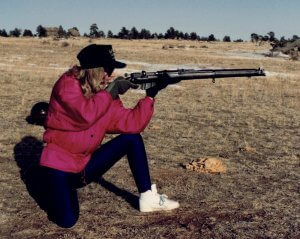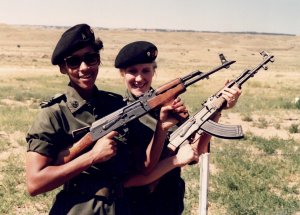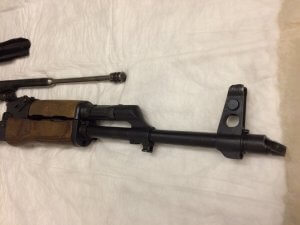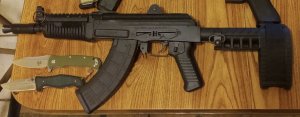The So-called “Krinks”

They Used to be Hard to Get.
In the Soviet section of my library, an old wind-up Russian alarm clock and Red Army belt with 5-sided star buckle gather dust on a shelf in front of the books.
Both were given to me by my tovarich Steve V.
Steve has been “Stephan Robertovich” to me since he sat next to me in Russian language class when we were freshmen at the Air Force Academy.
A lovely young lady named Marina C. sat on the other side of me in that class. We referred to her as “Cadyeta C,” as most of us taking Russian were Doolies, but she was an upperclassman (we addressed her by her title and her entire last name, which I will not list here). I was quite smitten with Cadyeta C.
Marina wore Hope perfume. Not one of my hopes regarding her ever came to fruition. But I digress.
Soviet consumer goods, for the most part, were junk. Their military gear was hardy. The Russkis chrome lined the barrels of their AKs, but their toilet seats would break after a few sittings. When Stephan Robertovich gave me that clock and the belt, though, they were quite exotic, becasue they were hard to get in those days.
It may be difficult for somebody raised in the global economy after The Wall between East and West Germany came down to understand, but during the Cold War, Warsaw Pact goods were almost impossible to find in the West. In the late 1980s, Steve was stationed in Turkey, monitoring Soviet ICBM launches, and was able to get the Russian clock and belt there.
Before The Wall came down, CIA officers paid handsomely–sometimes with their very lives–to smuggle examples of the latest military hardware out of Warsaw Pact controlled zones.
In 1979, the Soviets invaded Afghanistan, hoping to export their own brand of nearly universal poverty and Marxist atheism. The Afghans already had enough poverty, and would not tolerate atheism.
The Soviets neither understood not accepted the concept that there is any such thing as “collateral damage.” To the Red Army, the Afghans were bismachi, “bandits;” killing bismachi wives and kids was a bonus, a good way to keep more bismachi from populating the Hindu Kush. The Afghans, armed at first with little more than bolt-action Lee-Enfield rifles, stood up to being bombed and gassed long enough for Yuri Andropov to admit that “There is no future for Afghanistan without Islam.”

During the 1980s Soviet occupation of Afghanistan, the first examples of the AKS-74U fell into Western hands. If you don’t know what an AKS-74U is, a brief explanation is in order.
Soviet Small Arms Nomenclature
The Soviets, in a rare exception to their Marxist opposition to rewarding individual achievement, included the name of the designer or manufacturing concern in their weapons designations. Kalashnikov designed the avtomat Kalashnikova (AK). Simonov the samozaryadnyyj karabin (sistemy) Simonova (SKS). Yevgeny Dragunov, the somonoznaya vintovka Dragunova (SVD) sniper rifle. Like the M1 Garand, or Browning High Power.
The original AK-47 was adopted in 1947. It had a receiver milled out of a block of steel.
Later, the Soviets figured out how to make AK receivers out of cheaper, easier to manufacture stamped steel. That “modernized” AK was called the AKM (when Clint Eastwood said “This is the AK-47 assault rifle, the preferred weapon of your enemy,” he was really holding an AKM–but once again, I digress . . .).

A folding stock AKM for paratroopers was an AKMS.
In the 1970s, the Soviets jumped on the microcaliber band wagon, cashing in the AKM’s 7.62x39mm cartridge for a 5.45×39.5mm cartridge similar in concept to the US military’s 5.56x45mm.

The Kalashnikov chambered for the new cartridge, adopted in 1974, became–you guessed it–the AK-74.
The Shortie
The Soviets developed a short version of the AK-74, the AKS-74U, for officers, paratroopers, and support troops. When CIA officers first obtained them, during the Soviet occupation of Afghanistan, we called them “Krinkovs.”
Our understanding in the 1980s, parroted by several relatively authoritative sources at the time, was that Krinkov was the name of a high ranking Soviet officer, the first to be captured with a shortie AK. We had almost nobody who spoke Pashto or Urdu, and depended on our Pakistani “allies” to translate for us.
In 2002, the US invaded Afghanistan, hoping to bring them neo-natal healthcare, non-chattel status for women, and an economy based on anything other than exporting opium and violent Islamic jihad. We stayed longer than the Russians, and were more selective about who we killed. We even made a few friends. The end result was similar.
While we were there, we developed slightly better linguistic ability and found out that our word “Krinkov” was likely a bastardized Anglicization of a word that meant “short Kalashnikov” to the Afghans.

In October of 2006, I took a course called “AK-47 / 74 in CQB.” It was mostly about retention and using the Kalashnikov as an impact tool. The lead instructor was Saulius “Sonny” Puzikas, formerly of the Spetsnaz. Puzikas called the shortie a маленькая сучка, pronounced “malen’kaya suchka,” or simply “suchka” for short.
Malen’kaya means “little,” and suchka (sometimes pronounced sushka or suka) means, well, uh, “female dog.”
They also call it a OKYPOK (“oh-kur-rock“), which means “cigarette butt” in Russian. Certainly apropos: it’s stubby, and one end can burn you.
The Expansion Chamber
Speaking of the business end, for many years, the Soviets had difficulty chopping down the AK to make a shortie.
They kept running into the same problem we did trying to chop the M16. We couldn’t simply cut off the barrel in front of the A-frame, keeping all that beautiful sight radius, if we wanted it to operate reliably. Here’s why.
Gas operated rifles depend on a certain amount of back pressure bleeding into the gas system through a hole in the barrel. While the bullet is still in the barrel, it provides that pressure by giving the expanding gasses something to push against. As soon as the bullet leaves the barrel, the pressure inside drops to about one atmosphere. Refer to Mind the Gas Port, in the Intel section of this website, for further explanation.

With shorter barrels, the bullet isn’t in the barrel as long, so less impulse is delivered to the gas system. We solved that on the M16 by moving the front sight assembly (the “A-frame”) with its gas block (later, on flat tops, just the gas block) back. This gives us less sight radius, but about that time optics came along and we stopped worrying about the distance between the iron sights.
The Soviets solved the problem by placing an expansion chamber in front of the gas block. I’m no engineer, but my understanding is, gasses build up in the expansion chamber, prolonging the time there is back pressure bleeding into the gas system long enough to cycle the action.
The expansion chamber looks like a tiny soup can. There’s a connical flash hider in front of it, that does very little to hide the massive flash of unused powder still burning after the bullet leaves the short barrel.
This expansion chamber became part of the “Krinkov look.” Now, shorties like the slightly longer SAM-7 come with a wider outer dimension to the barrel in that place, even though there is NO expansion chamber inside the barrel.

For info about how to run a shortie, regardless of what you call it, see Firing the Stockless Shortie in the Intel section.
–George H, Lead Instructor, Heloderm LLC
